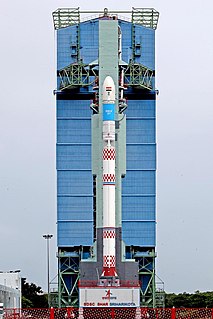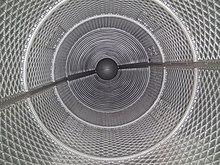
The Polar Satellite Launch Vehicle (PSLV) is an expendable medium-lift launch vehicle designed and operated by the Indian Space Research Organisation (ISRO). It was developed to allow India to launch its Indian Remote Sensing (IRS) satellites into sun-synchronous orbits, a service that was, until the advent of the PSLV in 1993, was commercially available only from Russia. PSLV can also launch small size satellites into Geostationary Transfer Orbit (GTO).

The Geosynchronous Satellite Launch Vehicle Mark III, also referred to as the Launch Vehicle Mark 3 (LVM3), is a three-stage medium-lift launch vehicle developed by the Indian Space Research Organisation (ISRO). Primarily designed to launch communication satellites into geostationary orbit, it is also identified as the launch vehicle for crewed missions under the Indian Human Spaceflight Programme and dedicated science missions like Chandrayaan-2. The GSLV Mk III has a higher payload capacity than the similarly named GSLV Mk II.

Oceansat-2 is the second Indian satellite built primarily for ocean applications. It was a part of the Indian Remote Sensing Programme satellite series. Oceansat-2 is an Indian satellite designed to provide service continuity for operational users of the Ocean Colour Monitor (OCM) instrument on Oceansat-1. It will also enhance the potential of applications in other areas. The OceanSat-2 mission was approved by the government of India on 16 July 2005.
IRS-P3 was the sixth satellite in Indian Remote Sensing satellite series, an Earth observation mission launched under the National Natural Resources Management System programme (NNRMS) undertaken by Indian Space Research Organisation (ISRO). The objectives of the mission were processing and interpretation of data generated by its two instruments, the Wide-Field Sensor (WiFS) and Modular Opto-electric Sensor (MOS), developed by the German Aerospace Center (DLR).
IRS-1E was an Earth observation mission launched under the National Natural Resources Management System (NNRMS) programme by Indian Space Research Organisation (ISRO). Sometimes written IRS-P1. The objective of the mission was to develop Earth imagery using instruments carried on board. Due to a malfunction of the launch vehicle, the satellite deviated from its path and plunged into the Indian Ocean.
Oceansat-1 or IRS-P4 was the first Indian satellite built primarily for ocean applications. It was a part of the Indian Remote Sensing Programme satellite series. The satellite carried an Ocean Colour Monitor (OCM) and a Multi-frequency Scanning Microwave Radiometer (MSMR) for oceanographic studies. Oceansat-1 thus vastly augment the IRS satellite system of Indian Space Research Organisation (ISRO) comprising four satellites, IRS-1B, IRS-1C, IRS-P3 and IRS-1D and extend remote sensing applications to several newer areas.
PSLV-C34 was the 36th mission of the PSLV program and 14th mission of PSLV in XL configuration. The PSLV-C34 successfully carried and deployed 20 satellites in the Sun-synchronous orbit. With a launch mass of 320,000 kilograms (710,000 lb) and payload mass of 1,288 kilograms (2,840 lb), the C34 set a new record of deploying the maximum number of satellites by Indian Space Research Organisation in a single mission. The PSLV-C34 carried One Cartosat-2 satellite, SathyabamaSat, Swayam & 17 other satellites from United States, Canada, Germany & Indonesia.
PSLV-C35 was the successful mission of the Polar Satellite Launch Vehicle program which set eight satellites in space. It was launched on 26 September 2016 by Indian Space Research Organisation (ISRO) from the Satish Dhawan Space Centre at Sriharikota.
PSLV-C1 was the overall fourth mission of the Polar Satellite Launch Vehicle (PSLV) program by Indian Space Research Organisation (ISRO). The vehicle carried IRS-1D satellite which was deployed in the Sun-synchronous orbit (SSO). This was India's first launch vehicle built without Russian assistance and PSLV's first operational flight placed IRS-1D into a polar orbit. However, it could not place the satellite in the desired circular orbit but in an elliptical orbit due to a leak of helium gas from one of the components. The mission was termed partial failure since the satellite could not be placed at the desired altitude.
KITSAT-3 was a South Korean remote sensing minisatellite which carried MEIS and SENSE instruments to low Earth orbit (LEO). Launched on 26 May 1999 by Indian space agency Indian Space Research Organisation (ISRO), on orbit the satellite was renamed to Uribyol-3. Manufactured by KAIST Satellite Technology Research Center (SaTReC), KITSAT-3 was developed with experience from KITSAT-1 and KITSAT-2 and was the first independently designed South Korean satellite.
DLR-Tubsat was a German remote sensing microsatellite, developed in a joint venture between Technical University of Berlin (TUB) and German Aerospace Center (DLR). TUB was responsible for the satellite bus and DLR was responsible for the payload. The satellite was launched into orbit on 26 May 1999, on the fifth mission of the PSLV program PSLV-C2. The launch took place in the Sriharikota Launching Range. The satellite had an expected life of one year.
PSLV-C3 was the third operational launch and overall sixth mission of the PSLV program. This launch was also the forty-sixth launch by Indian Space Research Organisation since its first mission on 1 January 1962. The vehicle carried three satellites which were deployed in the Sun-synchronous Low Earth orbit. The vehicle carried Technology Experiment Satellite, BIRD and PROBA. This was India's and ISRO's second commercial spaceflight. PSLV-C3 was launched at 10:23 a.m. IST on 22 October 2001 from Satish Dhawan Space Centre.
PSLV-C4 was the fourth operational launch and overall seventh mission of the PSLV program. This launch was also the forty-eight launch by Indian Space Research Organisation since its first mission on 1 January 1962. The vehicle carried and injected India's first dedicated Meteorological satellite, Kalpana-1 into the Geosynchronous transfer orbit. PSLV-C4 was launched at 15:53 hours IST on 12 September 2002 from Satish Dhawan Space Centre.
PSLV-C5 was the fifth operational launch and overall eighth mission of the Polar Satellite Launch Vehicle program. This launch was also the fifty-second launch by the Indian Space Research Organisation (IRSO) since its first mission on 1 January 1962. The vehicle carried and injected India's remote sensing satellite Resourcesat-1 into a sun-synchronous orbit; this was the heaviest and most sophisticated satellite built by IRSO through 2003. PSLV-C5 was launched at 04:52 hours Coordinated Universal Time on 17 October 2003 from Satish Dhawan Space Centre.

PSLV-C6 was the sixth operational launch and overall ninth mission of the PSLV program. This launch was also the fifty-fourth launch by Indian Space Research Organisation since its first mission on 1 January 1962. The vehicle carried and injected India's two satellites; Cartosat-1 and HAMSAT into the Sun-synchronous orbit. PSLV-C6 was launched at 04:44 hours Coordinated Universal Time on 5 May 2005 from the second launch pad of the Satish Dhawan Space Centre.

PSLV-C37 was the 39th mission of the Indian Polar Satellite Launch Vehicle (PSLV) program and its 16th mission in the XL configuration. PSLV-C37 successfully carried and deployed a record 104 satellites in sun-synchronous orbits. Launched on 15 February 2017 by the Indian Space Research Organisation (ISRO) from the Satish Dhawan Space Centre at Sriharikota, Andhra Pradesh. According to ISRO, the 101 international satellites were launched as part of a commercial arrangement between several firms and its commercial arm Antrix Corporation Limited, run under the auspices of the Indian Government's Department of Space.

The Small Satellite Launch Vehicle (SSLV) is a small-lift launch vehicle developed by ISRO with payload capacity to deliver 500 kg (1,100 lb) to low Earth orbit or 300 kg (660 lb) to Sun-synchronous orbit for launching small satellites, with the capability to support multiple orbital drop-offs. SSLV is made keeping low cost, low turnaround time in mind with launch-on-demand flexibility under minimal infrastructure requirements.
Oceansat is a series of earth observation satellites built, launched, and operated by Indian Space Research Organisation, and dedicated to oceanography and atmospheric studies. Oceansat satellites facilitate a range of applications including documenting chlorophyll concentration, phytoplankton blooms, atmospheric aerosols and particulate matter as well as marine weather forecast to predict cyclones.








